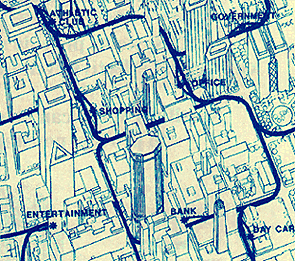
PRT network design would provide access to many urban locations.

PRT network design would provide access to many urban locations.
A question which often arises after examining these ideas is why has it taken so long to get "true" PRT into operation? The answer is due to a combination of many factors, notably political and technological.
The PRT concept germinated in the early 1950s and received enough attention by the mid 1960s to be the subject of government-funded analyses. By the early 1970s, there were many competing ideas on how to design automated transit systems, but there was no theory of PRT and there were insufficient funds to explore the dozens of alternative design features. This "Tower of Babel" discouraged decision makers, caused government funding to dry up, and left the continued search for an optimum configuration up to a few people.
A major reason it was possible in the 1980s to carry PRT research and development far enough to regain the attention of major transit decision makers was the emergence of the personal computer and associated software. Finding the optimum transit configuration and proving it required sophisticated and data- intensive engineering and economic calculations, detailed simulations of control and vehicle dynamics, and a great deal of data processing, which during the 1970s was much slower and required large resources, generally funded only by governments. The PC enabled engineers of ordinary means to purchase enough computer power to develop the optimum system and element designs. In parallel, the development of powerful fault-tolerant microprocessors and software elements have placed the control requirements of PRT well within the current state-of-the-art.
While many new ideas have emerged from institutional research during this century, new ideas in previous centuries generally emerged only when the individuals who discovered and developed them could do so without anyone else' approval. Development of PRT required understanding of engineering sciences and sophisticated technology of the 20th century melded with the individuals initiative of earlier centuries, a marriage made possible by the low-cost, high-performance personal computer.

Cargo capability can be easily built into a PRT system.
The PC and the microcomputer, coupled with the development of the necessary transit systems theory, test and operational experience with a wide variety of automated transit systems, the realization that conventional rail transit systems cannot solve the problems of congestion in cities, and the steady worsening of congestion and air pollution have made it possible for the idea of PRT to reemerge.
Careful research over decades has shown no flaw that will or should stop the development of PRT, but rather that PRT is a badly needed solution to a variety of transit problems. It is a new configuration of now very ordinary parts well within the current state-of-the-art.
Development of new concepts in public transportation differs from development of many other emerging concepts in that the resources needed to prove a concept are large, many people are involved in deciding to take a positive step, the level of credibility must be unusually high, and the "fear factor" that drove military programs is not present. In such circumstances, it is not surprising that several decades have been required to bring the concept of PRT to maturity.